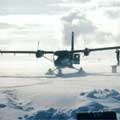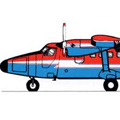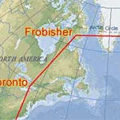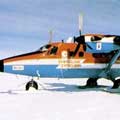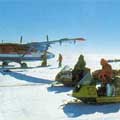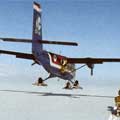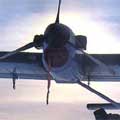The Aircraft: Twin Otter
In selecting an aircraft for use on the Transglobe Expedition’s Antarctic and Arctic phases several important factors had to be taken into account. The aircraft had to be both mechanically reliable and well proved as it is a single aircraft operation. It also had to be able to withstand landing and take off in far from ideal ground and ice surface conditions.
It had to have sufficient range and payload to resupply the ice group during the crossings on both polar ice caps and, most importantly, the aircraft had to have a short take off and landing capability due to the lack of large flat areas in the regions in which the ice group would be operating. Taking all these points into consideration, it was decided that the de Havilland of Canada Twin Otter was the ideal aircraft. The Twin Otter is a light twin turbo-prop aircraft, powdered by two Pratt & Whitney PT6A-27 free turbine engines, and has an all up weight of 12,500 pounds (5,700 kgs). In its commuter role the Otter carries 20 passengers and two crew, whereas in the cargo role (as the expedition will use it) the usual payload is about 2,000 pounds (900 kgs) depending on the range required. The greater the range, the less payload can be carried and surface conditions in the polar regions also govern take-off weight.
The Twin Otter being used by the expedition is owned and being generously loaned by the Chubb Group. It is a 300 series and was the first Twin Otter on the British Aircraft Register, hence the registration G-BDHC. It is to be repainted red, white and blue, and all top surfaces will be black to absorb as much heat as possible from the sun and to prevent ice from forming on the aircraft. It is a technique used with success by another operator of Twin Otters in the Antarctic: The British Antarctic Survey. The Twin Otter will be equipped in the wheel/ski configuration which means the pilot has the option of landing on wheels on prepared runways, such as the McMurdo ice runway in the Antarctic and during the ferry flight to the Antarctic, or he can select skis for field landings during the polar crossings.
The skis are operated by hydraulics, and a system of hydraulic rams moves the skis up and down around the fixed undercarriage. The undersurfaces of the skis are coated in a teflon-type finish which is designed to prevent the skis from sticking to the ice or snow when parked overnight.
As navigation by compass is difficult in the polar regions, one of the latest navigation aids has been obtained: The Canadian Marconi “Omega” system, CMA734, works essentially on very low frequency global radio transmissions. Several stations throughout the world transmit signals which are collected in the aircraft and, in conjunction with other information fed into it, the system computes the position of the aircraft. This type of navigational device is essential to enable the aircrew to locate the ice group during their polar crossings.
Another aid for locating the ice group to be carried by the aircraft is a very high frequency (VHF) homer. This is a system for tracking signals transmitted by the ice group when in reasonable proximity. An indicator in the cockpit tells the pilot which way to go — left or right.
The two man crew of the aircraft consists of Giles Kershaw, the pilot, who has been flying in the Antarctic for the last five summer seasons with the British Antarctic Survey, and is a very experienced pilot on Twin Otters, especially in the ski configuration, and the engineer, Gerry Nicholson, who has just completed 3 summer seasons in the Antarctic working on Twin Otters. G-BDHC is due to leave England in early December, flying via Reykjavic (Iceland), Frobisher Bay (Canada), Toronto (Canada), Miami (USA), South Caicos (Turks & Caicos Islands), Trinidad (Caribbean), Manaus (Brazil), Asuncian (Paraguay), Salta & Mar Del Plata (Argentina), Comodoro Rivadavia (Brazil), Stanley (Falkland Islands), Rothera and Halley (two British Antarctic Survey bases in the Antarctic) and finally to Sanae (a South African base). Here the aircraft meets the Expedition’s ship – MV Benjamin Bowring – and the main expedition. The ferry flight of some 12,000 miles (19,200 kms) should take eleven flying days if the weather is kind.
As the ship starts unloading, the aircraft begins to fly the expedition’s equipment and provisions to Borga where the party will overwinter. Once these flights are completed and the base camp established the aircraft will return to England via the ferry route to go on charter in March 1980.
Later in the year as the Antarctic winter gives way to summer the aircraft will return to the Antarctic by the end of October 1980, ready to assist the ice group on its 2,600 mile (4,160 kms) journey to Scott Base on the Ross Ice Shelf via the South Pole. The aircraft will be used for resupply of food and fuel and also to find alternative routes should obstacles confront the ice group.
The resupply work will either be done by landing near the ice group or, should no suitable areas be available, the stores will be air dropped. During the crossing the aircraft operates first from Borga and then when the ice group is near the South Pole it will fly via South Pole, to McMurdo on the Ross Ice Shelf whence it will cover the second half of the crossing from Williams Airfield.
The base party from Borga will travel with the aircraft on this flight and establish a new radio link at McMurdo. Once the ice group arrives the aircraft prepares to return to UK either via South Pole, Rothera and the normal ferry route or via New Zealand and Australia to allow for visits to the trade exhibitions in these countries. On arrival back in the UK the aircraft again goes on charter.
The next and last phase of the expedition which will require air support is in the Arctic in early February 1982. Positioning the aircraft for this means a flight from the UK to Iceland, Labrador, Toronto, Winnipeg, Yellowknife, Resolute and finally to the base camp at Alert in Northern Canada. From Alert support is provided while the ice group travels over the sea ice to the North Pole and then on to Spitsbergen. The pilot for this phase of the Expedition will be Karl Zberg. As the ice group progresses from the North Pole towards Spitsbergen so the aircraft and the base camp crew change to Cape Nord, Greenland and eventually to Longyearbyen, in Spitsbergen, to cover the last part of the ice group’s journey. During the crossing of the North Pole the Expedition’s ship will sail to the Spitsbergen area and will gather the ice group from the edge of the sea ice and return to England. Once the ice group is safely aboard the ship the aircraft returns to the United Kingdom via Bodo in Norway, to await the ultimate arrival of the expedition team.

